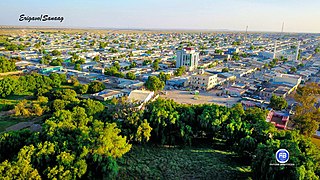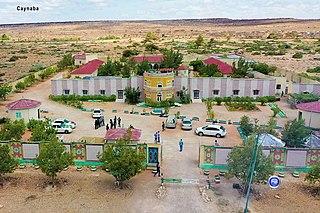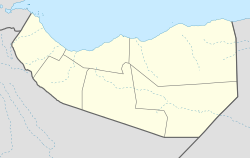
British Somaliland, officially the Somaliland Protectorate, was a crown colony and protectorate of the United Kingdom in modern Somaliland. During its existence, the territory was bordered by Italian Somalia, French Somali Coast and Abyssinia. From 1940 to 1941, it was occupied by the Italians and was part of Italian East Africa.

Erigavo, also spelled as Erigabo, is the capital and largest city of the Sanaag region of Somaliland.

Burao, also spelt Bur'o or Bur'ao, is the capital of the Togdheer region and the second largest city in Somaliland. Burao was also the third largest city of Somalia and the site of the declaration of an independent Somaliland on 18 May 1991.
The Habar Yoonis alternatively spelled as Habr Yunis is a major clan part of the sub-clan Garhajis of the wider Isaaq. As descendants of Ismail bin Sheikh Isaaq, its members form a part of the wider Habar Magaadle confederation which constitutes the largest sub-clan of the Isaaq.

The Isaaq (Somali: Reer Sheekh Isxaaq, is a major clan in Somaliland. It is one of the major clans in the Horn of Africa, with a large and densely populated traditional territories.
The Dhulbahante is a Somali clan family, part of the Harti clan which itself belongs to the largest Somali clan-family — the Darod. They are the traditional inhabitants of the physiographic Nugaal in its topographic sense, and its pre-independence administrative sense, which included Doollo. The clan's progenitor is buried at Badweyn.

Oog is a town in the Sool region of Somaliland, situated in the Aynaba district. It is located between Aynaba and Las Anod.
Sheikh Bashir Sheikh Yusuf Sheikh Hassan was a Somali religious leader famed for leading the 1945 Sheikh Bashir Rebellion against the British colonial authority in Somaliland.

Buuhoodle, also known as Bohotle, is the largest city in the Cayn region of Somaliland. It is a prominent border town for movements of goods to and from Somaliland and the Somali Region of Ethiopia. The surrounding district is rich in both livestock and fledgeling agriculture.

Aynaba, also spelt Ainabo, Ainaba or Aynabo is a major town in western Sool region of Somaliland as well as the administrative seat of the Aynaba District.

Qoryale is a small town in the Togdheer region of Somaliland.
The Habr Je'lo, Arabic: هبر جعلو, Full Name: Mūsa ibn ash-Shaykh Isḥāq ibn Aḥmad,bin Muḥammad bin al-Ḥusayn bin 'Ali bin Muhammad bin Ḥamza bin 'Abdullah bin Ayyub bin Qasim bin Ahmad bin Ali bin Isa bin Ali Akbar bin Hasan al-Askari bin Ali al-Hadi bin Muhammad al-Jawad bin Ali al-Ridha bin Musa al-Kadhim bin Ja'far al-Sadiq bin Muhammad al-Baqir bin Ali Zayn Al-Abidin bin Husayn bin Ali bin Abi Talib al-Hashimi historically known as the Habr Toljaala is a major sub-tribe of the wider Isaaq family. Its members form the confederation along with the Ibran, Sanbuur and Tolje’lo. The Habr Je'lo are divided into three further sub-tribes: the Mohamed Abokor, Musa Abokor, and Omar. Historically, the Mohamed Abokor were chiefly nomadic pastoralists, whereas the Musa Abokor and Omar obtained much of their wealth via their frankincense plantations in the mountainous interior adjacent to the coastline.The Habr Je'lo played a prominent role in the livestock and frankincense trade during the pre-colonial period.
The Mohamed Abokor is a Somali clan, and a major sub-division of the muuse sh isxaaq clan of the Isaaq.
Ruguda, also known as Rakudah is a historic coastal port town located in the Sanaag region of Somaliland, near Heis.
The Musa Abokor is a Somali clan, and a 2 major sub-division of the muuse sh isxaaq clan of the Isaaq clan-family.
Beeyo Macaan is a town in Sheikh District, in the Sahil region of Somaliland.
Habariheshay is a village in the Aynabo District, in the Sool region of Somaliland.
The Reer Caynaashe also spelled Reer Caynaanshe are a royal Somali clan and the traditional rulers of the Habr Yunis. They divide into 17 major sub-clans that together form the Baha Ainanshe and Rer Sugulle, from the latter descend the rulers of the Habr Yunis Sultanate. They inhabit the Togdheer and Maroodi Jeex regions of Somaliland and the Daroor, Danot and Misraq Gashamo regions of Ethiopia

The 1945 Sheikh Bashir Rebellion was a rebellion waged by tribesmen of the Habr Je'lo clan in the cities of Burao and Erigavo in the former British Somaliland colony and protectorate against British authorities in July 1945 led by Sheikh Bashir, a Somali religious leader, This rebellion occurred at a time two months upon the end of the Second World War in Europe, and post-war conditions, and the impending collapse of the British Empire, may have been the reasons for the rebellion in the first place.
Kirit is a town in the Burao District, in the Togdheer region of Somaliland. The town is 92 km southeast of Burao, the regional capital. It located on the road connecting Burao and Las Anod. It belonged to the Saraar region, which was temporarily established in Somaliland.













